Enzymes are catalysts. Most are proteins. (A few ribonucleoprotein enzymes have been discovered and, for some of these, the catalytic activity is in the RNA part rather than the protein part.)
Enzymes bind temporarily to one or more of the reactants of the reaction they catalyze. In doing so, they lower the amount of activation energy needed and thus speed up the reaction.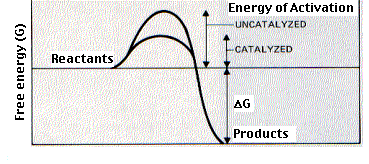 Examples:
Examples:
H2O2 -> H2O + O2
A single molecule of catalase can break 5.6 million molecules of hydrogen peroxide each minute.CO2 + H2O <-> H2CO3
It enables red blood cells to transport carbon dioxide from the tissues to the lungs. [Discussion]
A single molecule of carbonic anhydrase can process 36 million molecules of substrate each minute.| Link to discussion of the noncovalent forces that hold macromolecules together. |
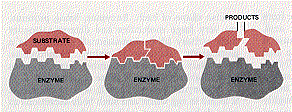
Most of these interactions are weak and especially so if the atoms involved are farther than about one angstrom from each other. So successful binding of enzyme and substrate requires that the two molecules be able to approach each other closely over a fairly broad surface. Thus the analogy that a substrate molecule binds its enzyme like a key in a lock.
This requirement for complementarity in the configuration of substrate and enzyme explains the remarkable specificity of most enzymes. Generally, a given enzyme is able to catalyze only a single chemical reaction or, at most, a few reactions involving substrates sharing the same general structure.

The necessity for a close, if brief, fit between enzyme and substrate explains the phenomenon of competitive inhibition.
One of the enzymes needed for the release of energy within the cell is succinic dehydrogenase.| Link to illustrated discussion of the citric acid cycle. |
Coenzymes may be covalently bound to the protein part (called the apoenzyme) of enzymes as a prosthetic group. Others bind more loosely and, in fact, may bind only transiently to the enzyme as it performs its catalytic act.
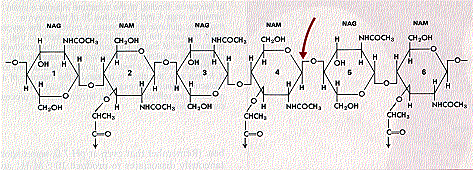 A number of lysozymes are found in nature; in human tears and egg white, for examples. The enzyme is antibacterial because it degrades the polysaccharide that is found in the cell walls of many bacteria. It does this by catalyzing the insertion of a water molecule at the position indicated by the red arrow. This hydrolysis breaks the chain at that point.
A number of lysozymes are found in nature; in human tears and egg white, for examples. The enzyme is antibacterial because it degrades the polysaccharide that is found in the cell walls of many bacteria. It does this by catalyzing the insertion of a water molecule at the position indicated by the red arrow. This hydrolysis breaks the chain at that point.
| Link to discussion of the bacterial cell wall and how it is affected by certain antibiotics. |
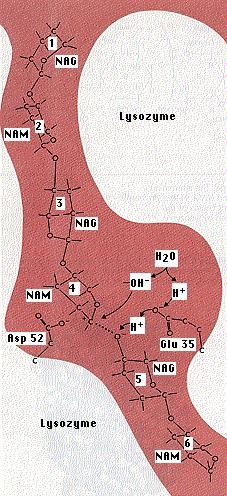
Lysozyme is a globular protein with a deep cleft across part of its surface. Six hexoses of the substrate fit into this cleft.
X-ray crystallography has shown that as lysozyme and its substrate unite, each is slightly deformed. The fourth hexose in the chain (ring #4) becomes twisted out of its normal position. This imposes a strain on the C-O bond on the ring-4 side of the oxygen bridge between rings 4 and 5. It is just at this point that the polysaccharide is broken. A molecule of water is inserted between these two hexoses, which breaks the chain. Here, then, is a structural view of what it means to lower activation energy. The energy needed to break this covalent bond is lower now that the atoms connected by the bond have been distorted from their normal position.
As for lysozyme itself, binding of the substrate induces a small (~0.75Å) movement of certain amino acid residues so the cleft closes slightly over its substrate. So the "lock" as well as the "key" changes shape as the two are brought together. (This is sometimes called "induced fit".)
The amino acid residues in the vicinity of rings 4 and 5 provide a plausible mechanism for completing the catalytic act. Residue 35, glutamic acid (Glu-35), is about 3Å from the -O- bridge that is to be broken. The free carboxyl group of glutamic acid is a hydrogen ion donor and available to transfer H+ to the oxygen atom. This would break the already-strained bond between the oxygen atom and the carbon atom of ring 4.
Now having lost an electron, the carbon atom acquires a positive charge. Ionized carbon is normally very unstable, but the attraction of the negatively-charged carboxyl ion of Asp-52 could stabilize it long enough for an -OH ion (from a spontaneously dissociated water molecule) to unite with the carbon. Even at pH 7, water spontaneously dissociates to produce H+ and OH- ions. [Discussion] The hydrogen ion (H+) left over can replace that lost by Glu-35.
The reaction is now complete. The chain is broken, the two fragments separate from the enzyme, and the enzyme is free to attach to a new location of the bacterial cell wall and continue its work of digesting it.
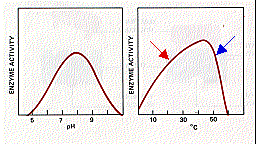 The activity of enzymes is strongly affected by changes in
pH and temperature. Each enzyme works best at a certain pH (left graph) and temperature (right graph), its activity decreasing at values above and below that point. This is not surprising considering the importance of
The activity of enzymes is strongly affected by changes in
pH and temperature. Each enzyme works best at a certain pH (left graph) and temperature (right graph), its activity decreasing at values above and below that point. This is not surprising considering the importance of
Changes in pH alter the state of ionization of charged amino acids (e.g., Asp, Lys) that may play a crucial role in substrate binding and/or the catalytic action itself. Without the unionized -COOH group of Glu-35 and the ionized -COO- of Asp-52, the catalytic action of lysozyme would cease.
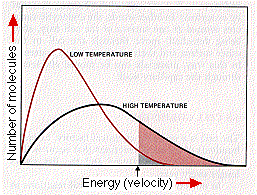
Hydrogen bonds are easily disrupted by increasing temperature. This, in turn, may disrupt the shape of the enzyme so that its affinity for its substrate diminishes. The ascending portion of the temperature curve (red arrow in right-hand graph above) reflects the general effect of increasing temperature on the rate of chemical reactions (graph at left). The descending portion of the curve above (blue arrow) reflects the loss of catalytic activity as the enzyme molecules become denatured at high temperatures.
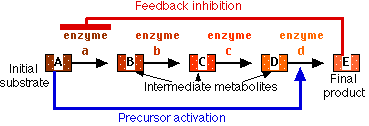
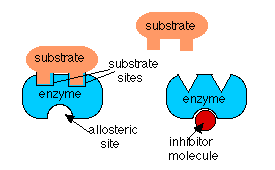
In the case if feedback inhibition and precursor activation, the activity of the enzyme is being regulated by a molecule which is not its substrate. In these cases, the regulator molecule binds to the enzyme at a different site than the one to which the substrate binds. When the regulator binds to its site, it alters the shape of the enzyme so that its activity is changed. This is called an allosteric effect.
The four mechanisms described above regulate the activity of enzymes already present within the cell.
What about enzymes that are not needed or are needed but not present?
Here, too, control mechanisms are at work that regulate the rate at which new enzymes are synthesized. Most of these controls work by turning on - or off - the transcription of genes.
If, for example, ample quantities of an amino acid are already available to the cell from its extracellular fluid, synthesis of the enzymes that would enable the cell to produce that amino acid for itself is shut down.
Conversely, if a new substrate is made available to the cell, it may induce the synthesis of the enzymes needed to cope with it. Yeast cells, for example, do not ordinarily metabolize lactose and no lactase can be detected in them. However, if grown in a medium containing lactose, they soon begin synthesizing lactase - by transcribing and translating the necessary gene(s) - and so can begin to metabolize the sugar.
| Link to a discussion of how transcription is controlled in E. coli. |
| Welcome&Next Search |